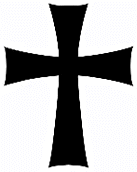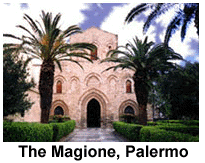...Best of Sicily presents... Best of Sicily Magazine. ... Dedicated to Sicilian art, culture, history, people, places and all things Sicilian. |
by Luigi Mendola | |||
Magazine Index Best of Sicily Arts & Culture Fashion Food & Wine History & Society About Us Travel Faqs Contact Map of Sicily
|
By virtue of his consort, Henry claimed the Sicilian crown in 1194 following the brief and ineffectual reign of Tancred, an "illegitimate" prince. His wife may have been a Norman princess, but the Sicilians did not welcome Henry and his suite of German knights and retainers very warmly. The new king installed several commanderies of recently-founded Teutonic Order of knights in Sicily, appropriating for them (from the Cistercians) Palermo's Magione church and cloister (shown), which they held for several centuries, and constructing for them the Church of Saint Mary of the Germans in Messina. Though only a few walls and arches remain, Saint Mary is one of the few examples of more-or-less pure Gothic architecture in Sicily. Henry's Sicilian reign didn't last long, and he was succeeded by his son Frederick II. The Order of Saint Mary of Jerusalem (the Teutonic Order) was founded in 1190 during the Third Crusade, on the model of the Hospitallers, to care for crusaders from central Europe taken ill. Pope Celestine recognised the order in 1192. By 1198 it had become a powerful military-religious order. To some degree this reflected the increasing interest of the Hohenstaufens in Palestine, and the knights warmly welcomed Frederick during his visit in 1229. The Templars, another military-religious
order, did not, and for this Frederick confiscated most of their holdings
in Sicily (though these were given to the Hospitallers The Teutonic Order left Palestine in 1291. Like the Templars and Hospitallers, they eventually garnered for themselves extensive holdings in Europe, establishing their grand magistracy in Prussia in 1309. But their zealous military exploits in Prussia, Poland and the Baltic lands did not always earn the knights sympathy from the common man. A major defeat by Polish and Lithuanian forces in 1410 spelled the end for the Teutonic Order's military and economic power. The Reformation's winds of change dealt the order another strong blow. Politically, what cannot be overlooked is the importance of these loyal German knights to Henry VI and his son Frederick. Though the Order was autonomous, until 1250 its fealty in Sicily was to the Staufen dynasty. The Teutonic Knights left Sicily in 1492 on Papal orders based on a request of the King of Spain. The German decoration which became known as the Iron Cross was inspired by the Teutonic Knights' black cross on a white field. Later, the Nazi glorification of the Teutonic Knights (and even the Italian-born Frederick II) was, at best, misplaced, and at all events very misleading. In fact, the order was suppressed in most of the German states early in the nineteenth century, surviving mostly in Austria. The Teutonic Order exists today as a quasi-chivalric institution of the Catholic Church. About the Author: One of Sicily's foremost historians, Luigi Mendola is the author of two books. | ||
Top of Page |
 German knights aren't
usually the first thing one associates with medieval Sicily, but the connection
is an interesting one. In 1186, Constance Hauteville, the youngest child
of
German knights aren't
usually the first thing one associates with medieval Sicily, but the connection
is an interesting one. In 1186, Constance Hauteville, the youngest child
of  rather than the Teutonic Order).
rather than the Teutonic Order).